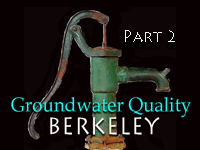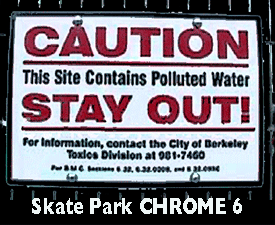
Brownfields INDEX
California's Brownfields Initiative: The Toxic Crisis
Federal estimates have determined that there are nearly half a million contaminated industrial properties scattered throughout the United States, They dot every major American city and contribute to urban blight and sprawl. Local governments have been virtually powerless in their attempts to break this development cycle. These toxic sites have been slow to redevelop because of their uncertain liability and the probable high cost of their cleanup. Most often, these properties are either left abandoned or are simply underutilized because of land use restrictions.
Some eastern cities, like Chicago, have reported as many as 2,000 of these contaminated industrial sites within a single metropolitan area. Nationally, it is estimated that one in eight no-residential properties has been contaminated. In an effort to combat this problem and to stimulate economic development, the Clinton administration and the Federal Environmental Protection Agency (EPA) have instituted an urban revitalization policy called the Brownfields Economic Development Initiative.
Brownfields, as these contaminated properties have come to be known, represent a broad spectrum of hazardous waste. Pollutants often include a vast array of extremely harmful chemicals and heavy metals. These sites have been reported to be among the most contaminated by both state and federal standards. In the past, the EPA has referred to these toxic industrial properties as "uncontrolled hazardous waste sites." EPA has stated that "uncontrolled hazardous waste sites may present some of the most serious environmental and public health problems the nation has ever faced." [1]
Several months ago, the EPA announced a relaxation of cleanup standards and the removal of 25,000 brownfield sites from its Superfund list, The ripples from these regulatory actions have already been felt in every state, as the active cleanups of 70 sites, nationwide, were recently halted. Since 1993 and the federal program's first pilot project in Cleveland, Ohio, an additional 17 EPA grants have been handed out to municipalities wanting to participate in this brownfields study, including California's state capitol. Within the next two years, 50 more cities will be awarded these grants, which will aid them in bringing their petitions for brownfield status to completion.
The Comprehensive Environmental Response, Compensation, and Liability Act [42 U.S.C. § 9601 et seq.], most commonly known as the Superfund Act, came about as a consequence of the recognized impacts that these hazardous sites, like the highly publicized Love Canal, were having on public health and the environment. Now, in the present regulatory climate, the public is being asked to forget these toxic lessons of the past.
The Brownfields Initiative is being proposed as a new idea. However, it is really a return to a time, not long ago, when polluters were unregulated, sites went uncleaned, and public safety was forsaken for economic development. Brownfield deregulation is now being accepted by a number of states across the country. Acknowledged as having the strongest environmental regulations in the country, even California has been quick to jump on board. With the promise of jobs, community empowerment, and enhanced "quality of life," this initiative will effectively end environmental cleanups on these sites. It's no wonder that the Brownfields Initiative is being criticized for its elements of environmental racism. Let's examine one of California's brownfield projects to better understand these concerns.
The City of Emeryville: the Pilot Study
The City of Emeryville is positioned at the edge of the San Francisco Bay and encompasses approximately 1.2 square miles. Emeryville was recently given a $200,000 EPA grant to complete its application that would award brownfield status to the entire city. The city's redevelopment agency, a co-applicant, will match that amount. This two-year investigation will focus primarily on previous site investigations performed in the past decade.
In many ways, the City of Emeryville is typical of urban cities elsewhere in its longing for economic relief and redevelopment. It is not surprising that these same cities often blame the lengthy bureaucratic process and the high costs of cleaning up brownfields for their loss of tax revenues and jobs. <READ MORE>
California's Brownfields Initiative: The Toxic Crisis L A Wood, California Environmental Law Reporter, May 1996, Volume 1996 Issue 5INDEX Below
- California's Choice: Containment Zones or Clean Water?
L A Wood, California Environmental Law Reporter, April 1996 - "On Berkeley Soil" video presentation" premiered on the
Berkeley City Council Agenda in March 1996. Produced by Erbele/Wood - Why is Emeryville, California is so toxic? (video)
Producers: Matthew Broersma & Aspasla Papavassiliou, Graduate School of Journalism, UC Berkeley February 10, 1996 - City of Berkeley, Toxics Management Division (TMD) June 19, 2013 UPDATE
Subject: Site Cleanup Program Transfers to the San Francisco Bay Regional Water Quality Control Board... Out of town & out of reach
ALSO SEE:
- Request to hold a workshop on Underground Storage Tank Program
Mayor Shirley Dean, September 26 1995- CONTAINMENT ZONE POLICIES, Background Information
March 5, 1996 CR# 96-008, COUNCIL ACTION- CONTAINMENT ZONE POLICY, FOR COUNCIL ACTION
From: Planning Commission, January 30, 1996- Containment Zone Policies (CR#96-008)
March 12. 1996 Council Minutes Page 8- To: Mr. Walter Pettit Executive Director State Water Resources Control Board
From City of Berkeley March 5, 1996- Letter to John Flores, City Manager
City of Emeryville, dated March 5, 1996- RE: AGENDA ITEM C(a)2 - CONTAINMENT ZONES
Clifford Fred, Planning Commissioner, March 5, 1996- Community Environmental Advisory Commission Recommendation
Adopt risk communication public notification and participation policy- GROUNDWATER CONTAMINATION/WATER POLICIES
December 22, 1995
- Unusual toxic waste plan in Emeryville, Town hopes to lure more businesses
Toxic City Applies for US Grant- City Council Challenges Emeryville’s Deregulation Plan
Apul Kirit Patel Daily Californian January 24, 1996- Berkeley debates industrial cleanup, Council to vote on Dean's letter
William Brand, Oakland Tribune, March 12, 1996- Debate over cleanup requirements creates additional mess for Berkeley
William Brand, Oakland Tribune, March 17,1996- On behalf of Emeryville
Alan H. Adler, Berkeley Voice, April 11, 1996- Inner city pollution threat
L A Wood , Berkeley Voice, January 25, 1996- Dirty story
Carolyn Erbele, Berkeley Voice, February 22, 1996
- HAMILTON • COHN • THATCHER & ASSOCIATES, Oakand, CA
RE: Containment Zone, March 11, 1996- Berkeley Chamber Of Commerce "OPPOSITE THE GOLDEN GATE"
RE: Proposed Containment Zone Policy, March 12, 1996- Lawrence Livermore National Laboratory Report: Bad science
L A Wood, City of Berkeley- Department of Non-attainment
L A Wood, East Bay Express, January 12, 1996- Deep in the Heart of Toxins
L A Wood, East Bay Express, December 6, 1996
- UPDATE ON EMERYVILLE'S BROWNFIELD REDEVELOPMENT PROJECT
COUNCIL INFORMATION, September 17, 1996, CR# 96-029- CITY OF EMERYVILLE Brownfield Project
John Flores, City Manager , August 20, 1996- Recommendation for L A Wood for Emeryville's Brownfields Pilot Project taskforce
CONSENT CALENDAR 10/29/96, From: Councilmember Dona Spring- To: Mayor Nora Davis City of Emeryville
Berkeley Taskforce candidates October 18, 1996
- Re: Future relaxation of the clean-up standards to our ground waters must be approved through a public hearing processTo: Loretta Larsarmian, Executive Officer - San Francisco Bay Regional Water Quality Control Board
From: City of Berkeley, November 20, 1995- Proposed Amendment to State Water Resources Control Board Resolution No. 92-49 ("Containment Zone Policy")
To: Mr. William Atwater, Chief Counsel State Water Resources Control Board
August 19, 1996 From N. Gregory Taylor General Counsel
Metropolitan Water District of Southern California #1309
WRE/ColorTech site (CLEANUP) at 1225 Sixth Street, Berkeley, Alameda County
Berkeley Toxic Management Division - San Francisco Regional Water Quality Control Board
- Executive Officer's report, July 11, 2001, Re: File No. 01S0241 (BG)
San Francisco Regional Water Quality Control Board, July 11, 2001- To: L A Wood, December 12, 2000, Re: File No. 01S0241 (BG)
From: San Francisco Regional Water Quality Control Board,- To: Berkeley Toxic Management Division, Re: File No. 01S0241 (BG)
From: San Francisco Regional Water Quality Control Board- Re: Alleged Regulatory Conflict of Interest
City of Berkeley, Office of the Attorney, December 11, 2000City of Berkeley Public Works Corporation Yard Site Remediation
- Public Works Corporation Yard Remediation
L A Wood, October 4, 1993- Corpyard cleanup may wait for advanced technology
Shannon Morgan, Berkeley Voice, September 9,1993
All Rights Reserved







